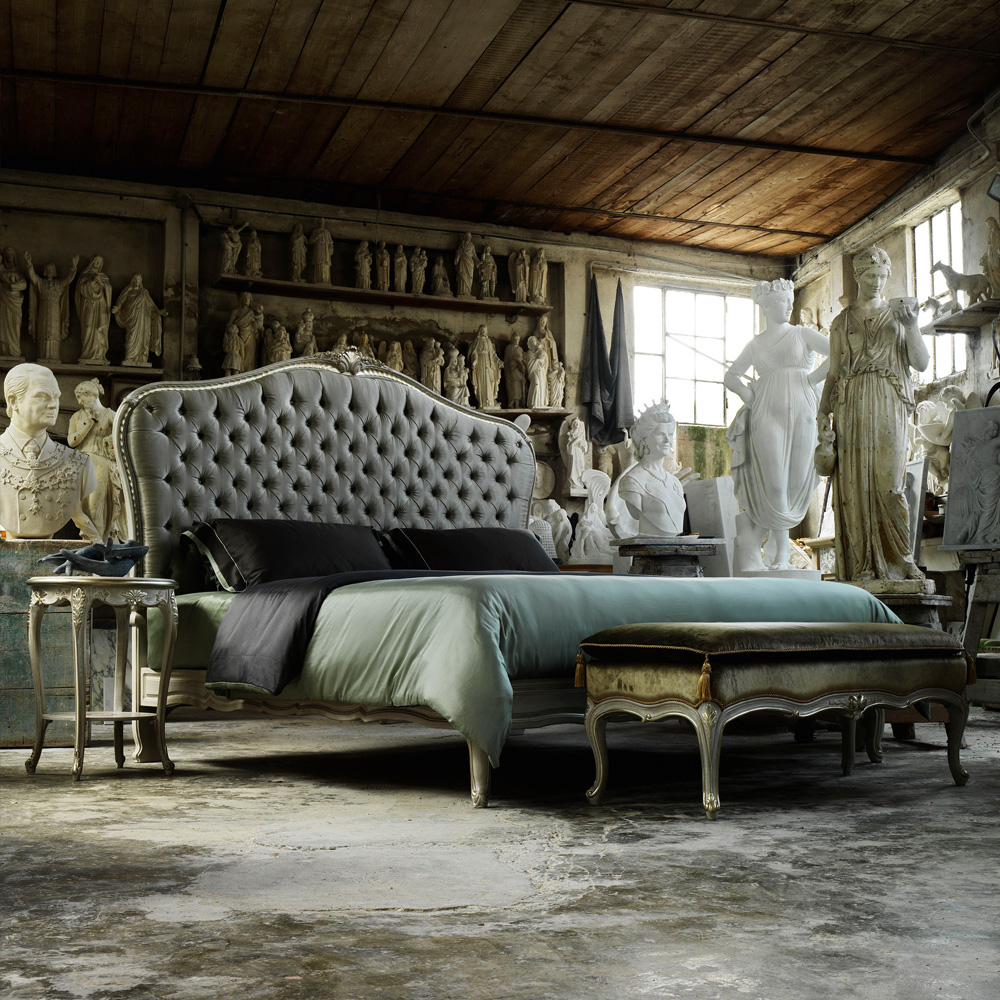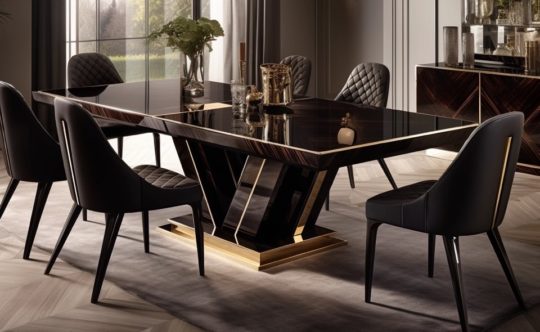
From the heavily adorned style of Louis XIV, to Queen Anne’s classic elegance, royals have long served as a source of inspiration for furniture makers and designers. And as the world prepares for King Charles’ coronation, there’s no better time to explore the influence monarchies have had on interior trends throughout history. So, let’s look into some of the most successful and luxurious styles from centuries past, and how to incorporate them into your home today.
Louis XIV
Arguably one of the most impactful sovereigns in terms of furniture design of all time is Louis XIV. Famous for his long reign and indulgent lifestyle, he was also known as the Sun King. This was due to choosing the sun, symbolising Apollo, god of peace and the arts, as his personal emblem upon his coronation. Louis XIV’s taste for the finer things reflected in everything he did. In fact, his main residence, Chateaux de Versailles, is still considered one of the most luxurious palaces in the world today.
During the late 17th Century, French furniture makers crafted some of the most intricate and opulent pieces ever seen. Initially designed to decorate the grand halls of Versailles and other royal residences, the style is characterised by its grandeur. It features large, heavy designs adorned with ornate carvings and gilding. One of its most iconic items is the Louis armchair, dramatic and throne-like, with an upholstered high back, arms and seat, and signature wood frame. Browse our stunning range of Louis style and reproduction furniture here.
-
 Luxury Louis Style Armchair And Footstool£5,736.00 – £14,212.00
Luxury Louis Style Armchair And Footstool£5,736.00 – £14,212.00 -
 High End Designer Louis Reproduction Writing Desk£9,445.00
High End Designer Louis Reproduction Writing Desk£9,445.00 -
 Italian Designer Louis XIV Dining Table Set£3,439.00 – £29,030.00
Italian Designer Louis XIV Dining Table Set£3,439.00 – £29,030.00 -
 Luxury Italian Ivory Louis Reproduction Sofa£16,850.00 – £27,585.00
Luxury Italian Ivory Louis Reproduction Sofa£16,850.00 – £27,585.00
-
 Tall Louis Style Chest Of Drawers£11,204.00
Tall Louis Style Chest Of Drawers£11,204.00 -
 Classic Louis XVI Style Chaise Longue£15,834.00
Classic Louis XVI Style Chaise Longue£15,834.00
Queen Anne
A few years later – and a short trip across the Channel – we find a very different style coming to power. Queen Anne’s reign between 1702-1714 saw the rise of remarkable simplicity in English furniture design. Also referred to as “Late Baroque”, Queen Anne furniture was revolutionary. Combining ergonomic design, expert craftsmanship, and high-quality materials to achieve comfort and sophistication. With clean lines and graceful curves, the style favoured form and versatility over decoration, featuring distinctive cabriole legs, supportive high backs and subtle swooping silhouettes.
Georgian
Following Queen Anne’s death, the Havoverians inherited the throne: a reign of six monarchs that began with George I and ended with Victoria. This period saw a dramatic shift in furniture styles – from understated elegance to absolute extravagance.
George I ruled Hanover with a court culture heavily influenced by France and Italy. So, when he acceded to the English throne, Anglo-Dutch styles were swiftly replaced with lavish Baroque designs. When George II came into power, so did the Rococo: a more playful evolution of Baroque born out of resistance to King Louis XIV’s more formal, geometric look. This furniture was often asymmetrical and decorated to the extreme, which made it an ornament in its own right.
-
 Elegant Italian Baroque Antique Gold Console And Mirror£8,894.00 – £25,295.00
Elegant Italian Baroque Antique Gold Console And Mirror£8,894.00 – £25,295.00 -
 Reproduction Baroque Round Glass Classic Italian Dining Set£3,208.00 – £24,449.00
Reproduction Baroque Round Glass Classic Italian Dining Set£3,208.00 – £24,449.00
Perhaps the most iconic of the Georgian era was Chippendale design, which emerged after the coronation of King George III. It mixed Gothic, Rococo and Chinese stylistic elements to create harmonious pieces prized for their arches and S-shaped curves. Chinoiserie had become popular in England during the 18th Century as a result of growing trade with China and other areas of East Asia – a relationship that George had famously attempted to strengthen during his time on the throne.
-
 Antique Finish Silver Rococo Dressing Table Set£1,892.00 – £10,165.00
Antique Finish Silver Rococo Dressing Table Set£1,892.00 – £10,165.00 -
 Luxury Ornate Carved Rococo Bed£12,466.00 – £14,959.20
Luxury Ornate Carved Rococo Bed£12,466.00 – £14,959.20
When people went in search of something new, designers looked to ancient civilisations for artistic guidance. Neoclassicism eventually evolved into Regency, which drew inspiration from architecture as opposed to antiques and artefacts. In addition to bold lines and heavy shapes, Regency styles often included golden inlaid Egyptian motifs. This was due to Napoleon’s conquest of Egypt and the subsequent increase in public awareness of its ancient monuments. These pieces caught the eye of the Prince Regent, whose collection remains on display at the Royal Pavilion in Brighton, UK.
-
 Neoclassical Style Low Sofa£13,034.00
Neoclassical Style Low Sofa£13,034.00 -
 Neoclassical Mahogany Writing Desk And Chair£4,285.00 – £16,610.00
Neoclassical Mahogany Writing Desk And Chair£4,285.00 – £16,610.00
Victoria
By the time of Queen Victoria’s coronation in 1838, the classical styles of the Georgian and Regency era were became less available. Whilst still considered immensely beautiful, they were not the most practical, and people yearned for solution that was both comfortable and luxurious. Stories say the Chesterfield sofa was born out of frustration when Lord Stratton, fourth Earl of Chesterfield, was unable to find a piece that suited all his needs as an English nobleman: a rest for his writing arm, a back for sitting upright, and a smart, tailored aesthetic to match his own.
The design was first depicted in a painting of Queen Victoria’s drawing room in 1857. After that, it quickly caught on as a symbol of class and wealth. In fact, a number of Chesterfield designs are still present within the walls of Balmoral and Buckingham Palace.
-
 Large Button Upholstered Velvet Sofa£15,550.00 – £16,945.00
Large Button Upholstered Velvet Sofa£15,550.00 – £16,945.00 -
 Modern Low Button Upholstered Suede Sofa£22,037.00 – £22,524.00
Modern Low Button Upholstered Suede Sofa£22,037.00 – £22,524.00 -
 Italian Designer Nubuck Leather Button Upholstered Sofa£22,954.00
Italian Designer Nubuck Leather Button Upholstered Sofa£22,954.00 -
 Italian Leather Modern Chesterfield Sofa£10,716.00 – £15,866.00
Italian Leather Modern Chesterfield Sofa£10,716.00 – £15,866.00
Furniture inspired by royalty has played a significant role in interior design for centuries. So, what influence might Charles III have during his reign? Will he stick to the traditional styles favoured by previous monarchs? Or perhaps he will be associated with more contemporary movements, such as mid-century minimalism or sustainable design. We, at Juliettes Interiors, are certainly looking forward to finding out after the coronation.
-
 Contemporary Round Walnut Dining Table£8,010.00 – £8,450.00
Contemporary Round Walnut Dining Table£8,010.00 – £8,450.00 -
 Designer Contemporary Furry Walnut Arm Chair and Footstool£2,410.00 – £9,705.00
Designer Contemporary Furry Walnut Arm Chair and Footstool£2,410.00 – £9,705.00
-
 Rustic Recycled Wood Coffee Table Nest£1,821.00
Rustic Recycled Wood Coffee Table Nest£1,821.00 -
 Industrial Old Oak Coffee Table£1,862.04
Industrial Old Oak Coffee Table£1,862.04
We’re Here to Help
Remember, if you need any help choosing your luxury furniture, our design team is always on hand to advise on sizes, colours, fabrics and finishes – or to design the perfect space for you. Just contact us or pop into our Chelsea showroom. We would love to meet you.




















